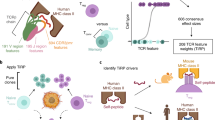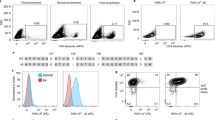Abstract
Several surface molecules appear to be involved in antigen recognition by human T lymphocytes including the monomorphic 20/25K T3 structure present on all mature T lymphocytes and the subset-specific associative recognition elements, T4 and T8 (refs 1–8). More recently, Ti1, a clonally unique antigen recognition structure comprised of a 49,000 molecular weight (49K) α-chain and a 43K β-chain, linked to T3 was identified on a major histocompatibility complex (MHC) class I specific T8+ T-cell clone, CT8III (ref. 9). To determine whether analogous receptor molecules could be found on other T-cell clones of differing specificity, we produced monoclonal antibodies against a clonal structure (Ti2) on an MHC class II specific T4+ lymphocyte, CT4II, derived from the same donor as CT8III. The Ti2 structure on CT4II is shown here to be a disulphide-linked heterodimer like Ti1 on CT8III and is composed of summits of similar molecular weight. Monoclonal antibodies against Ti2 or Ti1 block antigen specific functions of the respective clone without showing any cross-reactivity. These findings suggest that each T lymphocyte, regardless of subset derivation or specificity, uses an analogous Ti heterodimer for antigen specific function. The latter is linked to T3 and expressed on the cell surface at an identical density (30,000–40,000 sites per cell).
This is a preview of subscription content, access via your institution
Access options
Subscribe to this journal
Receive 51 print issues and online access
$199.00 per year
only $3.90 per issue
Buy this article
- Purchase on Springer Link
- Instant access to full article PDF
Prices may be subject to local taxes which are calculated during checkout
Similar content being viewed by others
References
Reinherz, E. L. et al. Cell 30, 735–743 (1982).
Meuer, S. C. et al. Science 218, 471–473 (1982).
Reinherz, E. L., Hussey, R. E. & Schlossman, S. F. Eur. J. Immun. 10, 758–762 (1980).
Meuer, S. C., Schlossman, S. F. & Reinherz, E. L. Proc. natn. Acad. Sci. U.S.A. 79, 4395–4399 (1982).
Reinherz, E. L. et al. Nature 294, 168–170 (1981).
Landegren, U. et al. J. exp. Med. 155, 1579–1584 (1982).
Biddison, W. E., Rao, P. E., Talle, M. A., Goldstein, G. & Shaw, S. J. exp. Med. 156, 1065–1076 (1982).
Reinherz, E. L. & Schlossman, S. F. Cell 19, 821–827 (1980).
Meuer, S. C. et al. J. exp. Med. 157, 705–719 (1983).
Kohler, G. & Milstein, C. Nature 256, 495–497 (1975).
Haskins, K. et al. J. exp. Med. 157, 1149–1169 (1983).
Nadler, L. M. et al. Hum. Immun. 1, 77–90 (1980).
Reinherz, E. L., Kung, P. C., Goldstein, G. & Schlossman, S. F. Proc. natn. Acad. Sci. U.S.A. 76, 4061–4065 (1979).
Ey, P. L., Prowse, S. J. & Jenkin, C. R. Immunochemistry 15, 429–436 (1978).
Loken, M. R. & Herzenberg, L. A. Ann. N.Y. Acad. Sci. 254, 163–188 (1975).
Muirhead, K. A., Schmitt, T. C. & Muirhead, A. R. Cytometry 3, 251–256 (1983).
Laemmli, U. K. Nature 227, 680–685 (1970).
Author information
Authors and Affiliations
Rights and permissions
About this article
Cite this article
Meuer, S., Acuto, O., Hussey, R. et al. Evidence for the T3-associated 90K heterodimer as the T-cell antigen receptor. Nature 303, 808–810 (1983). https://doi.org/10.1038/303808a0
Received:
Accepted:
Issue Date:
DOI: https://doi.org/10.1038/303808a0
This article is cited by
-
The structure of a T-cell mechanosensor
Nature (2019)
-
Structural basis of assembly of the human T cell receptor–CD3 complex
Nature (2019)
-
In vitro membrane reconstitution of the T-cell receptor proximal signaling network
Nature Structural & Molecular Biology (2014)
-
Jurkat T cells and development of the T-cell receptor signalling paradigm
Nature Reviews Immunology (2004)
-
Antigen recognition by human γδ T cells: pattern recognition by the adaptive immune system
Springer Seminars in Immunopathology (2000)
Comments
By submitting a comment you agree to abide by our Terms and Community Guidelines. If you find something abusive or that does not comply with our terms or guidelines please flag it as inappropriate.



